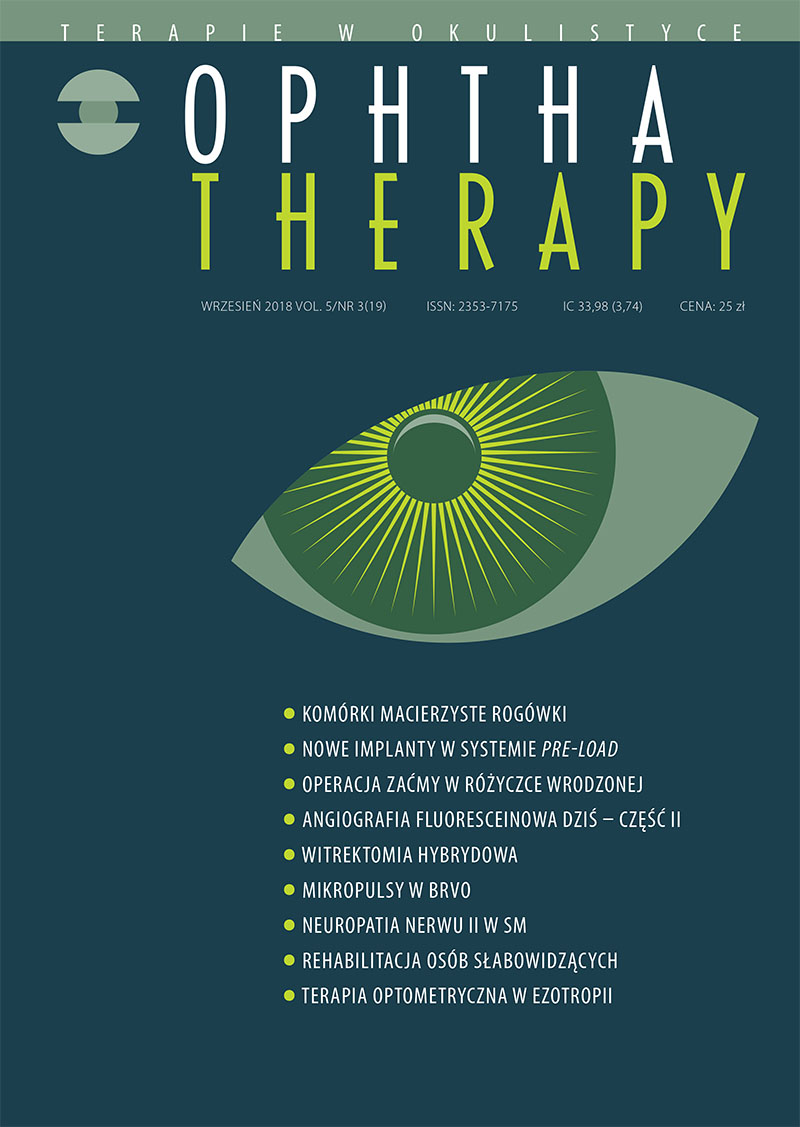Rehabilitacja osób słabowidzących na świecie
##plugins.themes.bootstrap3.article.main##
Abstrakt
Rehabilitacja osób słabowidzących staje się bardzo ważną gałęzią okulistyki, gdyż upośledzenie wzroku i ślepota są narastającym problemem nie tylko w krajach rozwijających się, lecz także wysoko rozwiniętych. Jest to bezpośrednia konsekwencja rosnącej średniej długości życia i starzenia się populacji. Upośledzenie widzenia ma olbrzymie konsekwencje społeczne i ekonomiczne, a działania rehabilitacyjne mogą mieć realny wpływ na ich zmniejszenie. Założeniem pracy jest przedstawienie celu i korzyści płynących z rehabilitacji osób słabowidzących, a także omówienie barier w dostępie do opieki oraz jej modeli w poszczególnych krajach.
Pobrania
##plugins.themes.bootstrap3.article.details##

Utwór dostępny jest na licencji Creative Commons Uznanie autorstwa – Użycie niekomercyjne – Bez utworów zależnych 4.0 Międzynarodowe.
Copyright: ? Medical Education sp. z o.o. License allowing third parties to copy and redistribute the material in any medium or format and to remix, transform, and build upon the material, provided the original work is properly cited and states its license.
Address reprint requests to: Medical Education, Marcin Kuźma (marcin.kuzma@mededu.pl)
Bibliografia
2. The European Blind Union. http://www.euroblind.org/about-blindness-and-partial-sight/facts-and figures.
3. Bourne RR, Stevens GA, White RA et al; Vision Loss Expert Group. Causes of vision loss worldwide, 1990-2010: a systematic analysis. Lancet Glob Health. 2013; 1(6): e339-49.
4. Harvey PT. Common eye diseases of elderly people: identifying and treating causes of vision loss. Gerontology. 2003; 49: 1-11.
5. U.S. Department of Health and Human Services. Vision Research ? A National Plan: 1999?2003. National Eye Institute, National Institutes of Health, Bethesda, USA: 98-4120.
6. World Health Organization. Change the Definition of Blindness (PDF). http://www.who.int/blindness/Change%20the%20Definition%20of%20Blindness.pdf?ua=1.
7. Klein BE, Klein R, Lee KE et al. Performance-based and self-assessed measures of visual function as related to history of falls, hip fractures, and measured gait time. The beaver dam eye study. Ophthalmology. 1998; 105: 160-4.
8. Leat SJ, Zecevic AA. Prevalence of vision loss among hospital in-patients; a risk factor for falls? Ophthalmic Physiol Opt. 2018; 38(1): 106-14.
9. van der Aa HPA, Comijs HC, Penninx BWJ et al. Major depressive and anxiety disorders in visually impaired older adults. Invest Ophthalmol Vis Sci. 2015; 56(2): 849-54.
10. Nollett CL, Bray N, Bunce C et al. Depression in visual impairment trial (DEPVIT): a randomized clinical trial of depression treatments in people with low vision. Invest Ophthalmol Vis Sci. 2016; 57(10): 4247-54.
11. Gold D, Simson H. Identifying the needs of people in Canada who are blind or visually impaired: Preliminary results of a nation-wide study. International Congress Series. 2005; 1282: 139-42.
12. Chakravarthy U, Biundo E, Saka RO et al. The Economic Impact of Blindness in Europe. Ophthalmic Epidemiol. 2017; 24(4): 239-47.
13. Suttie A, Howley E, Dryden G et al. Rehabilitation and older people with acquired sight loss. EBU 2014.
14. Walkiewicz M. Funkcjonalna ocena wzroku i proces wspomagania rozwoju widzenia u dzieci słabowidzących z niesprawnością złożoną. Wydawnictwo WSPS im. Marii Grzegorzewskiej, Warszawa 2000: 5-25.
15. Dagnelie G. Age-related psychophysical changes and low vision. Invest Ophthalmol Vis Sci. 2013; 54(14): ORSF88-93.
16. Owsley C, McGwin G, Lee PP et al. Characteristics of Low Vision Rehabilitation Servicesin the United States. Archives of Ophthalmology. 2009; 127(5): 681-9.
17. Leat S. A Proposed Model for Integrated Low-Vision Rehabilitation Services in Canada. Optom Vis Sci. 2016; 93(1): 77-84.
18. Pollard TL, Simpson JA, Lamoureux L et al. Barriers to accessing low-vision services. Ophthalmic Physiol Opt. 2003; 23: 321-7.
19. Spafford MM, Rudman DL, Leipert BD et al. When Self-Presentation Trumps Access: Why Older Adults With Low Vision Go Without Low-Vision Services. J Appl Gerontol. 2009; 29(5): 579-602.
20. Gustafsson J, Inde K. The history and current status of low vision services in Scandinavian countries. J Vis Impair Blind. 2009; 103: 558-62.
21. Lawrence M. Low vision care: The Kooyong experience. J Vis Impair Blind. 1985; 79: 337-40.
22. Culham LE, Ryan B, Jackson AJ et al. Low vision services for vision rehabilitation in the United Kingdom. Br J Ophthalmol. 2002; 86: 743.
23. Reeves BC, Harper RA, Russell WB. Enhanced low vision rehabilitation for people with age related macular degeneration: A randomised controlled trial. Br J Ophthalmol. 2004; 88(11): 1443-9.
24. Vision 2010: The Right to Sight. Asia Pacific Regional Low Vision Workshop, Hong Kong, 28Y30 May 2001. Geneva: World Health Organization, 2002. http://whqlibdoc.who.int/hq/2002/ WHO_PBL_02.87.pdf (Access: 29.06.2015].
25. Ronca M, Peach B, Thompson I et al. Demonstrating the impact and value of vision rehabilitation. A report to RNIB. August 2017. https://www.rnib.org.uk/sites/default/files/Demonstrating%20the%20impact%20and%20value%20of%20vision20rehabilitation%202017.pdf.
26. Jakubowski S. Środki techniczne w rehabilitacji i edukacji osób z niepełnosprawnością sensoryczną. In: Gorajewska D. Społeczeństwo równych szans ? tendencje i kierunki zmian. Stowarzyszenie Przyjaciół Integracji, Warszawa 2005: 149-67.
27. Lubawy H. Powiększalnik telewizyjny. Tyfloświat. 2008; 2(2): 9-13.
28. Stelmack JA, Tang XC, Reda DJ et al; LOVIT Study Group. Outcomes of the Veterans Affairs Low Vision Intervention Trial (LOVIT). Arch Ophthalmol. 2008; 126(5): 608-617.
29. Ehrlich JR, Ojeda LV, Wicker D et al. Head-Mounted Display Technology for Low-Vision Rehabilitation and Vision Enhancement. Am J Ophthalmol. 2017; 176: 26-32.
30. O?Brien EE, Mohtar AA, Diment LE et al. A Detachable Electronic Device for Use With a Long White Cane to Assist With Mobility. Assistive Technology 2014; 26(4): 219-26.
31. Chiang MF, Cole RG, Gupta S et al. Computer and World WideWeb accessibility by visually disabled patients: problems and solutions. Surv Ophthalmol. 2005; 50(4): 394-405.

